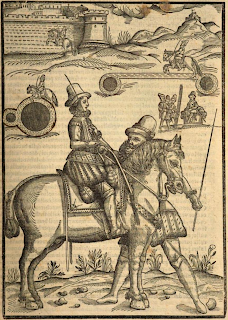Featured
- Get link
- X
- Other Apps
"Head stand where his hinder part stood" - MEZZA VOLTA

In descriptions of battles, skirmishes or other events, we can sometimes find such phrases as: "turn the horse's head where the rump was", but it would be worth knowing exactly what maneuver was meant (Mov. 1.).
Samuel Maszkiewicz, describing the maneuvers of the hussars in 1611, used the expression: "turn the horse's head where the rump was" [1]:
For example, the Italian Fedrrico Grisone in "Gli ordini di cavalcare" from 1550 writes:
„…ogni siata che darete la volta, in qualunque mano se sia, tenere questa misura di ponergli la testa dov’egli tiene la groppa, et chiuder la volte in quella parte, verso la qual’era il vostro viso, quando l’incominciaste."[2]
"... every time, when you make volta, on any hand, take this measure to place his head where he held his rump, and close the volta where your eyes were previously focused when you started it."
Also the Italian, Antonio Pirro Ferraro (teacher of Krzysztof Dorohstajski) in the chapter "Ultima Avertimenti Per Stringere il Cavallo al Repulone" from 1602 writes [3]:

"... turns back to make a volta in the same place, make it without anxiety, reduce with only [front] legs, where previously was his [back] foot; thus, he will do with tempo, not only in terms of his "mezza volta" [half turn]"
Englishman John Astley in 1595 in "The Art of Riding", writing about turning, notes:
„…and in that manner [turn] bring his forepart above, until he become into the path againe, so that his head stand where his hinder part stood,…”[4]
In the French work "Le Véritable Parfait Mareschal" from 1668 by Jacques de Solleysel, we can find a description of the "passade", that is a repelon made with tight half-pirouettes [5]:

"Finally, you will create and complete a
"passade", so that the horse is with its head where it previously had
its rump when you started the lesson, which is simply called
"passade",..."
Also the Englishman Thomas Bedingfild in the work "The Art of Riding" from 1584 writes:„If you like to use the same order in turning your horsse, you may doo it in this manner. When you have set your horsses head strait in the same path and place where he stood with his heels, without putting him any whit forward;…” [6]

"Finally, you will create and complete a
"passade", so that the horse is with its head where it previously had
its rump when you started the lesson, which is simply called
"passade",..."
„If you like to use the same order in turning your horsse, you may doo it in this manner. When you have set your horsses head strait in the same path and place where he stood with his heels, without putting him any whit forward;…” [6]
"It is also necessary to know, before you go on the straight track of the Repellons, [go] in trot when you come close to the end, since you want to [go in] walk, [and] shouldn't raise (to make the horse excited with voice etc), without halts with steady hand and straight. And in which (when) you want to turn him around, only raise [excited him] with your tongue, so he will soon settle down with little rotschen (hitting/whip?), and conform (could also be hasten) himself, and on the sides that you desire, [make] the tight Volta gracefully, also steady and fair, also don't take too high the shape (don’t lift horse too much), that the head stays where the rump was, and this (text) is of half time (mezzo tempo."
All of these works describe the turn that is used in the more advanced Reppelone's.
The Italians called this turn "mezza volta", or "half turn" with a radius equal to "almost the length of a horse", and it looked exactly like this [8]:
It was a turn in the form of a tight half-pirouette with three jumps (if made at a canter).
So we have correlations between this particular phrase: "turn the horse's head where the rump was" and a specific exercise well described in terms of technical performance contained in the equestrian European treaties of that time.
REFERENCES:
[1] Niemcewicz, Julian. "Zbiór pamiętników historycznych o dawnej Polszcze z rękopisów, tudzież dzieł w różnych językach o Polszcze wydanych, oraz z listami oryginalnemi królów i znakomitych ludzi w kraju naszym, Tom 2", Lipsk; Breitkopf i Haertel 1839, s. 280.
[2] Tobey, Elizabeth. Federico Grisone's "The Rules of Riding". Tempe, Arizona: ACMRS, 2014., s. 231.
[3] Ferraro, Pirro. "Cavallo Frenato", Neapol; Antonio Pace 1602, s. 49.
[4] Ashley, John. "The Art of Riding, set foorth in a breefe treatise, with a due interpretation of certeine places alleged out of Xenophon, and Gryson, very expert and excellent horsemen; wherein also the true vse of the hand by the said Grysons rules and precepts is speciallie touched; and how the author of this present worke hath put the same in practise; also what profit men may reape thereby; without the knowledge whereof, all the residue of the art of riding is but vaine. Lastlie, is added a short discourse of the chaine or cauezzan, the trench, and the martingale: written by a gentleman of great skill and long experience in the said art", London; Henrie Denham 1584 s. 28.
[5] Solleysel, Jacques. "Le véritable parfait maréchal... par de Solleysel", Trévoux 1668, s. 356
[6] Bedingfild, Thomas. "The art of riding conteining diuerse necessarie instructions, demonstrations, helps, and corrections apperteining to horssemanship; written at large ... a man most excellent in this art. (1584)", London; Henrie Denham 1584 s. 82.
[7] Grisone, Federico. "Künstlicher Bericht und allerzierlichste beschreybung des Edlen”, Wurzburg; Getruckt durch M. Manger in Verlegung G. Willers, 1570, s. 58.
[8] "Künstlicher Bericht und allerzierlichste beschreybung des Edlen”, s. 57.









